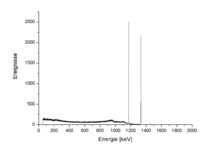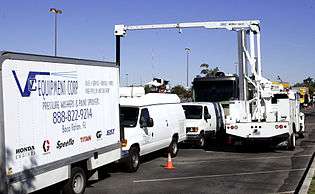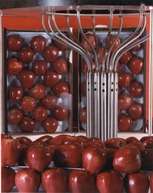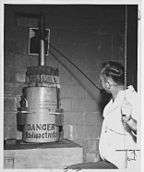Cobalt-60
| Cobalt-60 | |
|---|---|
| General | |
| Name, symbol | Cobalt-60,60Co |
| Neutrons | 33 |
| Protons | 27 |
| Nuclide data | |
| Natural abundance | trace |
| Half-life | 5.27 years[1] |
| Isotope mass | 59.9338222 u |
| Spin | 5+ |
| Decay mode | Decay energy |
| β (beta decay) | 0.31 MeV |
| γ (gamma-rays) | 1.1732,1.3325 MeV |


Cobalt-60, 60
Co
, is a synthetic radioactive isotope of cobalt with a half-life of 5.2714 years. It is produced artificially in nuclear reactors. Deliberate industrial production depends on neutron activation of bulk samples of the monoisotopic and mononuclidic cobalt isotope 59
Co
.[2] Measurable quantities are also produced as a by-product of typical nuclear power plant operation and may be detected externally when leaks occur. In the latter case (in the absence of added cobalt) the incidentally produced 60
Co
is largely the result of multiple stages of neutron activation of iron isotopes in the reactor's steel structures[3] via the creation of 59
Co
precursor. The simplest case of the latter would result from the activation of 58
Fe
. 60
Co
decays by beta decay to the stable isotope nickel-60 (60
Ni
). The activated nickel nucleus emits two gamma rays with energies of 1.17 and 1.33 MeV, hence the overall nuclear equation of the reaction is 59
27Co
+ n → 60
27Co
→ 60
28Ni
+ e− +
ν
e + gamma rays.
Activity
Corresponding to its half-life the radioactive activity of one gram of 60
Co
is 44 TBq (about 1100 curies). The absorbed dose constant is related to the decay energy and time. For 60
Co
it is equal to 0.35 mSv/(GBq h) at one meter from the source. This allows calculation of the equivalent dose, which depends on distance and activity.
Example: a 60
Co
source with an activity of 2.8 GBq, which is equivalent to 60 µg of pure 60
Co
, generates a dose of 1 mSv at one meter distance within one hour. The swallowing of 60
Co
reduces the distance to a few millimeters, and the same dose is achieved within seconds.
Test sources, such as those used for school experiments, have an activity of <100 kBq . Devices for nondestructive material testing use sources with activities of 1 TBq and more.
The high γ-energies result in a significant mass difference between 60
Ni
and 60
Co
of 0.003 u. This amounts to nearly 20 watts per gram, nearly 30 times larger than that of 238
Pu
.
Decay

The diagram shows a (simplified) decay scheme of 60
Co
and 60m
Co
. The main β-decay transitions are shown. The probability for population of the middle energy level of 2.1 MeV by β-decay is 0.0022%, with a maximum energy of 665.26 keV. Energy transfers between the three levels generate six different gamma-ray frequencies.[4] In the diagram the two important ones are marked. Internal conversion energies are well below the main energy levels.
60m
Co
is a nuclear isomer of 60
Co
with a half-life of 10.467 minutes. It decays by internal transition to 60
Co
, emitting 58.6 keV gamma rays, or with a low probability (0.22%) by β-decay into 60
Ni
.[5]
Applications

Co
gamma-ray scanner

Co
is in the central pipes
The main advantage of 60
Co
is that it is a high intensity gamma-ray emitter with a relatively long half-life, 5.27 years, compared to other gamma ray sources of similar intensity. The β-decay energy is low and easily shielded; however, the gamma-ray emission lines have energies around 1.3 MeV, and are highly penetrating.
The main uses for 60
Co
are:
- As a tracer for cobalt in chemical reactions
- Sterilization of medical equipment.[6]
- Radiation source for medical radiotherapy.[7] Cobalt therapy, using beams of gamma rays from 60
Co
teletherapy machines to treat cancer, has been widely used since the 1950s. - Radiation source for industrial radiography.[7]
- Radiation source for leveling devices and thickness gauges.[7]
- Radiation source for pest insect sterilization.[8]
- As a radiation source for food irradiation and blood irradiation.[6]
- As a radiation source for laboratory mutagenesis use.
- As a radiation source for stereoregular polymerization reactions, for example in preparation of syndiotactic polymethyl methacrylate.
Cobalt has been discussed as a "salting" element to add to nuclear weapons, to produce a cobalt bomb, an extremely "dirty" weapon which would contaminate large areas with 60
Co
nuclear fallout, rendering them uninhabitable. In one hypothetical design, the tamper of the weapon would be made of 59
Co
. When the bomb exploded, the excess neutrons from the nuclear fission would irradiate the cobalt and transmute it into 60
Co
. No nation is known to have done any serious development of this type of weapon.
.jpg)
Co
needle implanted in tumors for radiotherapy, around 1955.

Co
teletherapy machine for cancer radiotherapy, early 1950s.
.jpg)
Co
source in the pipe, center.

Co
source for sterilizing screwflies in the 1959 Screwworm Eradication Program.
Occurrence
There is no natural 60
Co
in existence; thus, synthetic 60
Co
is created by bombarding a 59
Co
target with a slow neutron source. Californium-252, moderated through water, can be used for this purpose, as can the neutron flux in a nuclear reactor. The CANDU reactors can be used to activate 59
Co
, by substituting the stainless steel control rods with cobalt rods.[9] In the United States, it is now being produced in a BWR at Hope Creek Nuclear Generating Station. The cobalt targets are substituted here for a small number of fuel assemblies.[10]
- 59
Co
+ n → 60
Co
Safety
After entering a living mammal (such as a human being), some of the 60
Co
is excreted in feces. The remainder is taken up by tissues, mainly the liver, kidneys, and bones, where the prolonged exposure to gamma radiation can cause cancer. Over time, the absorbed cobalt is eliminated in urine.[7]
Steel contamination
Cobalt is an element of steel alloys. Uncontrolled disposal of 60
Co
in scrap metal is responsible for the radioactivity found in several iron-based products.[11][12]
In August 2012, Petco recalled several models of steel pet food bowls after US Customs and Border Protection determined that they were emitting low levels of radiation. The source of the radiation was determined to be 60
Co
that had contaminated the steel.[13]
In May 2013 a batch of metal-studded belts sold by online retailer Asos were confiscated and held in a US radioactive storage facility after testing positive for cobalt-60.[14]
Incidents involving medical radiation sources
In 2000, a disused radiotherapy head containing a 60
Co
source was stored at an unsecured location in Bangkok, Thailand and then accidentally sold to scrap collectors. Unaware of the dangers, a junkyard employee dismantled the head and extracted the source, which remained unprotected for a period of days at the junkyard. Ten people, including the scrap collectors and workers at the junkyard, were exposed to high levels of radiation and became ill. Three of the junkyard workers subsequently died as a result of their exposure, which was estimated to be over 6 Gy. Afterward, the source was safely recovered by the Thai authorities.[15]
In December 2013, a truck carrying a disused 111 TBq 60Co teletherapy source from a hospital in Tijuana to a radioactive waste storage center was hijacked at a gas station near Mexico City.[16][17][18] The truck was recovered shortly after, but it was discovered that the thieves had removed the source from its shielding. It was found abandoned and intact in a field close by.[18][19] Despite early reports with lurid headlines asserting that the thieves were "likely doomed",[20] the radiation sickness was mild enough that the suspects were quickly released to police custody,[21] and no one is known to have died from the incident.[22]
Parity
In 1957, Chien-Shiung Wu et al. discovered the β-decay process violated parity, implying nature has a handedness.[23]
In the Wu experiment her group aligned radioactive 60
Co
nuclei by cooling the source to low temperatures in a magnetic field. Wu's observation was that more β-rays were emitted in the opposite direction to the nuclear spin. This asymmetry violates parity conservation.
Suppliers
Argentina, Canada and Russia are the largest suppliers of cobalt-60 in the world.
See also
References
- ↑ National Institute of Standards and Technology. "Radionuclide Half-Life Measurements". Retrieved 2011-11-07.
- ↑ Malkoske, G. R. Cobalt-60 production in CANDU power reactors
- ↑ US EPA [http://www.epa.gov/radiation/radionuclides/cobalt.html#wheredoes Radiation Protection: Cobalt
- ↑ "Table of Isotopes decay data". Retrieved April 16, 2012.
- ↑ "Table of Isotopes decay data". Retrieved April 16, 2012.
- 1 2 Gamma Irradiators For Radiation Processing (PDF). IAEA. 2005.
- 1 2 3 4 "Cobalt | Radiation Protection | US EPA". EPA. Retrieved April 16, 2012.
- ↑ Croatia fruit farmers fight flies
- ↑ Isotope Production: Dual Use Power Plants
- ↑ PSEG Nuclear's Hope Creek reactor back on line, begins production of Cobalt-60
- ↑ radioactive contamination of steel
- ↑ "Lessons Learned The Hard Way". IAEA Bulletin 47-2. International Atomic Energy Agency. Archived from the original on 18 July 2010. Retrieved 16 April 2010.
- ↑ "Petco Recalls Some Stainless Steel Pet Bowls Due to Cobalt-60 Contamination". Retrieved 21 August 2012.
- ↑ "Asos Belts Seized Over Radioactive Studs". Sky News. 2013-05-28. Retrieved 2013-12-05.
- ↑ The Radiological Accident in Samut Prakarn (PDF). IAEA. 2002. Retrieved 2012-04-14.
- ↑ "Truck with dangerous radioactive materials hijacked in Mexico - IAEA — RT News". RT. 2013-12-04. Retrieved 2013-12-05.
- ↑ "Mexico Informs IAEA of Theft of Dangerous Radioactive Source". IAEA. Retrieved 2013-12-05.
- 1 2 "Mexico Says Stolen Radioactive Source Found in Field". IAEA. 2013-12-05. Retrieved 2013-12-05.
- ↑ Will Grant (2013-12-05). "BBC News - Mexico radioactive material found, thieves' lives 'in danger'". BBC. Retrieved 2013-12-05.
- ↑ Gabriela Martinez, and Joshua Partlow (6 December 2013). "Thieves who stole lethal radioactive cobalt-60 in Mexico likely doomed". Los Angeles Daily News. Retrieved 12 March 2015.
- ↑ M. Alex Johnson (6 December 2013). "Six released from Mexican hospital but detained in theft of cobalt-60". NBC News. Retrieved 12 March 2015.
- ↑ Mary Cuddehe (13 November 2014). "What Happens When A Truck Carrying Radioactive Material Gets Robbed In Mexico". BuzzFeed. Retrieved 12 March 2015.
- ↑ Wu, C. S.; Ambler, E; Hayward, R. W.; Hoppes, D. D.; Hudson, R. P. (1957). "Experimental Test of Parity Conservation in Beta Decay". Physical Review. 105 (4): 1413–1415. Bibcode:1957PhRv..105.1413W. doi:10.1103/PhysRev.105.1413.
External links
- Cobalt-60, Centers for Disease Control and Prevention.
- NLM Hazardous Substances Databank – Cobalt, Radioactive
- Beta decay of Cobalt-60, HyperPhysics, Georgia State University.
- Dr. Henry Kelly. Cobalt-60 as a Dirty Bomb, Federation of American Scientists, March 6, 2002.